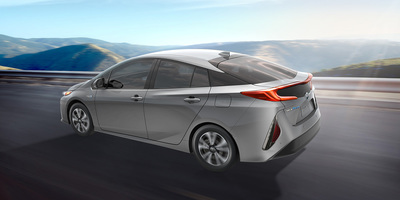HEELS ON WHEELS: 2017 TOYOTA PRIUS PRIME REVIEW
HEELS ON WHEELS: 2017 TOYOTA PRIUS PRIME REVIEW
HEELS ON WHEELS
By Katrina Ramser
San Francisco Bureau
The Auto Channel
INTRO TO THE PRIUS PRIME VEHICLE
The four-passenger Toyota Prius Prime is all about the bigger battery for extended electric-powered travel – you can get 22 miles on electric only – with the hybrid range (where the gas-powered engine kicks in) stretching this number to 600. The model also features stylistic standouts like quad LED head lights and a more curved hatch with carbon fiver accents, not to mention a more luxurious approach to the interior and the addition of helpful safety technology.
I drove a 2017 Toyota Prius Prime with the 1.8-liter DOHC VVT-I four-cylinder engine and Toyota’s Hybrid Synergy Drive system for a total output of 121 horsepower. The Prius Prime comes in three trims: the base Plus, Premium and Advanced. My top-of-the-line Advanced trim came with the following standard equipment: SofTex-trimmed and heated front seats; power driver’s seat; 11.6-inch touchscreen with a backup camera; an upgraded 10-speaker JBL audio system; Bluetooth technology; UBS and auxiliary input jack; 3-door Smart Key system; Smart-Flow Climate Control system; Qi-combatable wireless phone charger; push-button start; digital and color heads-up display; cargo tonneau cover; fifteen-inch alloy wheels. Price as described came to $33,100 without options.
The Nissan Leaf, Honda Fit EV, Kia Soul EV and its more auspicious competitor, the Chevrolet Volt, compete with the Prius. If you are not that familiar with the Prius family, there is also a Prius “v” offering a configurable second row for more cargo space and the smaller Prius “c” (the Prius Prime name replaces what was previously called the Plug-in hybrid version. See all specs and comparisons below my review)
HEELS ON WHEELS REVIEW CRITERIA
Stylish But Comfortable Results: Depending where you drive, you’re going to get either strange stares or compliments – I was approached by many admirers when I pulled up to Whole Foods, for example. I have to say the Prime model with its quad-LED headlights and integrated fog lights nails the new design. It’s all about the modern driver where the interior is concerned, from its futuristic curves and white-washed upholstery to the new 11.6-inch display screen which has practically doubled in size compared to previous models (it’s bigger than an iPad and can display climate, navigation, and music without screen crowding). Keep in mind this fits four passengers but it is much roomier than the Chevrolet Volt. The Volt a five-person vehicle but that’s a stretch – that fifth rear center passenger must uncomfortably straddle the cup holders, which proved to be cramped for a middle-school aged child during my test drive; I found the rear Prius much more accommodating. The Prius pays homage to the smartphone by giving it a desirable place to rest on a Qi-combatable wireless phone charger.
Reliability & Safety Factor: The 2017 Toyota Prius is a Top Safety Pick with The Insurance Institute for Highway Safety (IIHS) with ratings of “Good” in all areas. The vehicle is not yet rated by The National Highway Traffic Safety Administration (NHTSA). Toyota’s Star Safety System is standard and includes VSC, anti-lock brakes, EBD, traction control and an advanced airbag system. So much is built as standards for all models like the Pre-Collision System and Lane Departure Alert; but the Safety Connect (emergency roadside assistance) is a standard for the Advanced trim only along with the Intelligence Clearance Sonar with Intelligent Parking Assist.
Cost Issues: The base model Prius Plus starts at $27,100. My full-loaded Advanced trim with a few unnecessary extras (illuminated door sills, paint protection film) brought the total to $36,305 with delivery charges. A base 2017 Chevrolet Volt LT is $33,220 and the Premium is $37,570 with a recent fully loaded test drive total bringing the price to $40,050.
Activity & Performance Ability: The hybrid choice with extended electric power is the way to go to avoid the dreaded “range anxiety” felt on 100 percent electric vehicles. Comparing the Prius Prime’s 121 horsepower to the Volt’s 149, a drop in muscular propulsion didn’t affect my perspective: The Prius offers a smooth and attentive ride, and without the touchy brakes I felt on the Volt. After your journey, the digital cluster on the instrument panel will give you a driving score such as “71 out of 100” with suggestions on how to improve your numbers. Visibility remains a challenge but has been improved with the addition of safety technology – however, I find the repetitive “beep” when in reverse confusing as most makers preserve audio warnings for when something is about to go wrong. I experience the same limited visibility in the Volt and have found the C-MAX and Honda Fit to offer better rear vision.
The Green Concern: The Prius Prime has a distinct advantage over the Volt with an EPA estimate of 54 miles-per-gallon on gas only – the Volt will deliver the typical driver 42 miles-per-gallon on gasoline only. Combined with electricity and gas, the Prius Prime gets 133 miles-per-gallon equivalent with the Volt gets 106.
FINAL PARTING WORDS
The 2017 Toyota Prius Prime offers class and conservation in the extended range hybrid segment. Visibility issues plague both the Prius and its main competitor the Chevrolet Volt, but the addition of much-needed safety technology helps. I’d have to say in terms of space, price and fuel economy, the Toyota Prius Prime is the clear choice.
©2016 Katrina Ramser
The Most In-Depth Toyota Vehicle Consumer Shopper's Research - Anywhere!
MORE TOYOTA INFORMATION
- Toyota Buyers Guide | Specs, Prices, Expert Reviews and Comparisons 2017-1997
- Find Your Perfect New Vehicle Match
- Toyota Reviews From The Auto Channel (1993-Present)
- The Auto Channel's Toyota Brand Archives; News, Press Releases, Reviews, Specifications, Prices, Video, Images (66,006 Annotations)



